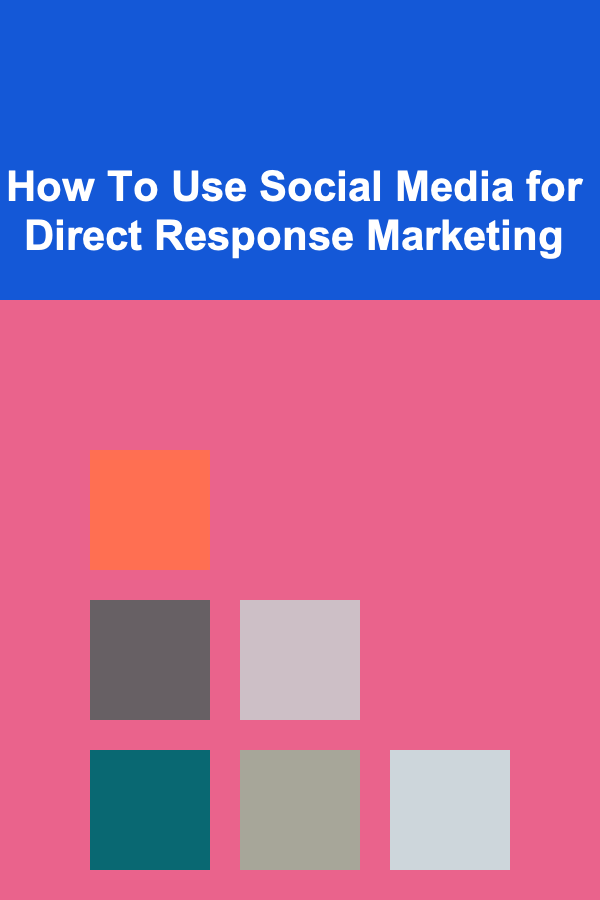
How To Use Social Media for Direct Response Marketing
ebook include PDF & Audio bundle (Micro Guide)
$12.99$6.99
Limited Time Offer! Order within the next:

Social media has evolved into one of the most powerful tools in digital marketing, offering brands an unprecedented opportunity to connect with their audience. With billions of active users globally, platforms like Facebook, Instagram, Twitter, LinkedIn, and TikTok have transformed the way businesses approach marketing. One of the most effective strategies on social media is Direct Response Marketing (DRM), a tactic designed to prompt an immediate response or action from the target audience. In this article, we will explore how to leverage social media for direct response marketing, breaking down the key components, strategies, and best practices.
What is Direct Response Marketing?
Direct Response Marketing refers to any marketing strategy or campaign that seeks to provoke an immediate and measurable response from the audience. The goal is clear: generate an action---whether it's making a purchase, signing up for a newsletter, filling out a form, or clicking a link. Unlike brand awareness campaigns, which focus on long-term engagement and recognition, DRM is focused on driving instant actions.
Key elements of Direct Response Marketing include:
- Clear Call to Action (CTA): Direct response campaigns must have a clear, compelling call to action. This could be "Buy Now," "Learn More," "Sign Up Today," or any other prompt that encourages immediate engagement.
- Measurable Results: Success is easily measured. Whether it's through clicks, conversions, or purchases, the outcome of a DRM campaign is quantifiable.
- Targeted Audience: Social media platforms offer advanced targeting options that allow marketers to reach highly specific segments of their audience. DRM takes full advantage of these capabilities to optimize results.
The Role of Social Media in Direct Response Marketing
Social media platforms are naturally suited for direct response marketing due to their massive user base, real-time interaction, and precision targeting capabilities. They allow businesses to engage with users in a way that feels personalized and immediate, which is the essence of DRM.
Benefits of Using Social Media for DRM
- Instant Communication and Engagement: Social media enables two-way communication, meaning brands can respond to questions, concerns, or comments in real-time. This immediacy is perfect for DRM campaigns, where immediate action is desired.
- Advanced Targeting: Platforms like Facebook and Instagram offer advertisers the ability to target audiences based on demographics, interests, behaviors, location, and even purchase history. This precision increases the likelihood of reaching the right people with the right message.
- Cost Efficiency: Compared to traditional advertising methods, social media advertising is often more cost-effective. Ads on platforms like Facebook, Instagram, and LinkedIn can be scaled to fit nearly any budget, making DRM accessible to businesses of all sizes.
- Visual Appeal: Social media is a highly visual platform, and DRM campaigns that leverage video, high-quality images, and compelling graphics tend to perform better. The more visually engaging your direct response content is, the more likely users are to act on it.
- Real-Time Analytics and Adjustments: Social media platforms provide detailed performance data, including clicks, conversions, engagement rates, and more. This allows businesses to track the effectiveness of their campaigns in real-time and adjust strategies accordingly.
Strategies for Using Social Media in Direct Response Marketing
When using social media for DRM, it's crucial to apply the right strategies to maximize effectiveness. Below are some essential strategies to implement for successful direct response marketing campaigns:
1. Leverage Paid Social Media Ads
Paid social media ads are one of the most effective ways to drive direct responses from a targeted audience. Social media platforms offer various ad formats, including carousel ads, video ads, story ads, and sponsored posts. These formats can be optimized for clicks, leads, or purchases, making them ideal for DRM.
Key Paid Ad Formats to Consider:
- Facebook and Instagram Ads: These platforms offer a wide range of ad types, from photo and video ads to carousel and slideshow ads. The robust targeting options allow for laser-focused campaigns, and their wide user base increases the chances of reaching potential customers.
- LinkedIn Ads: For B2B marketing, LinkedIn offers advanced targeting options to reach professionals in specific industries, companies, or job titles. Sponsored InMail ads can also be used to send personalized messages directly to users' inboxes, prompting immediate responses.
- TikTok Ads: Short-form video content is ideal for driving engagement. TikTok's interactive features, such as in-video links and call-to-action buttons, make it an excellent platform for direct response campaigns targeting younger audiences.
Best Practices for Paid Social Media Ads:
- A/B Testing: Test different variations of your ads (e.g., different headlines, CTAs, images, and copy) to see what resonates best with your target audience.
- Compelling CTAs: Your ad copy should always feature a strong, clear call to action, such as "Shop Now," "Claim Your Offer," or "Sign Up Today."
- Use Retargeting: Retarget users who have engaged with your previous content or visited your website but haven't yet converted. This increases the chances of a successful direct response.
2. Utilize Social Proof to Boost Conversions
Social proof, the concept of people relying on the opinions and actions of others, is a powerful motivator for encouraging immediate action. By showcasing positive reviews, testimonials, user-generated content (UGC), or influencer endorsements, you can build trust and credibility, which can lead to higher conversion rates.
Ways to Incorporate Social Proof:
- Customer Testimonials and Reviews: Feature satisfied customer reviews or testimonials on your posts or ads to demonstrate that others have had positive experiences with your product or service.
- Influencer Collaborations: Partner with influencers to create content that showcases your product in an authentic way. Influencer marketing has become a staple in social media advertising, and leveraging influencers who align with your brand can drive direct responses from their followers.
- User-Generated Content: Encourage your customers to share their experiences with your product on social media. Reposting user-generated content not only builds social proof but also increases engagement and trust.
3. Craft Urgency and Scarcity in Your Messaging
One of the best ways to prompt immediate action is by creating a sense of urgency or scarcity in your messaging. Limited-time offers, countdown timers, and exclusive deals can compel users to act quickly.
Tactics to Create Urgency and Scarcity:
- Limited-Time Offers: Advertise special deals or discounts that expire within a short period. For example, "50% off today only" or "Offer ends at midnight."
- Countdown Timers: Use countdown timers in your ads or posts to build excitement and show that the opportunity is about to expire.
- Limited Quantity Alerts: Mention that there are only a few items left in stock or that the offer is available for a limited number of customers.
4. Engage Through Interactive Content
Social media platforms thrive on interaction, and interactive content can be a powerful way to prompt a direct response. Interactive posts such as polls, quizzes, and challenges can encourage immediate participation and provide an opportunity to gather data on your audience.
Examples of Interactive Content:
- Polls and Surveys: Use polls on platforms like Instagram and Twitter to encourage engagement. These can be used to ask questions related to your product or service, which helps increase visibility and response rates.
- Quizzes: Offer a quiz that leads users to a personalized recommendation or discount. For instance, a skincare brand could create a quiz to recommend products, with the final result including a special discount code for the participant.
- Contests and Giveaways: Hosting a contest or giveaway is an excellent way to engage users while prompting them to take immediate action. Require participants to like, comment, or share a post to enter the giveaway, thus increasing engagement and brand awareness.
5. Optimize Your Landing Pages
Once users click on your social media ad or post, they need to be directed to a landing page that encourages conversion. A well-optimized landing page is essential to the success of your direct response marketing campaign.
Landing Page Best Practices:
- Consistency: Ensure that the messaging, offer, and design of the landing page are consistent with the ad that led the user there. Any disconnect between the ad and landing page can lead to confusion and lost conversions.
- Clear and Focused CTA: Your landing page should have a clear and obvious call to action. Avoid clutter and distractions, and focus on the primary goal of getting the user to take action.
- Fast Loading Speed: A slow-loading landing page can result in high bounce rates and lost conversions. Optimize your landing page to load quickly, ensuring users don't leave before converting.
6. Monitor, Analyze, and Adjust
One of the key advantages of social media advertising is the ability to monitor and measure campaign performance in real-time. By tracking key metrics such as click-through rates (CTR), conversion rates, and return on ad spend (ROAS), you can optimize your campaigns for better results.
Key Metrics to Track:
- Click-Through Rate (CTR): The percentage of people who clicked on your ad after seeing it. A high CTR indicates that your ad is engaging and relevant.
- Conversion Rate: The percentage of users who completed the desired action (e.g., making a purchase or signing up for a newsletter).
- Cost per Acquisition (CPA): The cost of acquiring a new customer or lead. Keep track of your CPA to ensure your campaigns remain cost-effective.
- Return on Ad Spend (ROAS): The revenue generated from your ad campaign compared to the amount spent on ads. A high ROAS indicates a successful direct response campaign.
By continuously analyzing your campaign data, you can identify which ads, messaging, and tactics are working best, allowing you to refine your strategy for even better performance.
Conclusion
Using social media for direct response marketing offers immense potential for businesses to generate immediate results. With the right strategies, businesses can leverage the targeting, engagement, and cost-effectiveness of social media platforms to drive clicks, conversions, and sales. By utilizing paid ads, social proof, urgency, interactive content, and optimized landing pages, you can create direct response campaigns that not only engage users but also prompt them to take action right away. As always, continuous monitoring and optimization are key to maximizing the effectiveness of your campaigns and achieving long-term success in social media marketing.

How to Create a Checklist for Staying Hydrated Throughout the Day
Read More
How to Negotiate Bills and Save Money on Monthly Expenses
Read More
How to Set Up a DIY Cocktail Bar for Your Guests
Read More
How to Navigate the Bustling Hubs of London
Read More
How To Boost Your Bone Density
Read More
How to Begin Mountain Biking Downhill
Read MoreOther Products

How to Create a Checklist for Staying Hydrated Throughout the Day
Read More
How to Negotiate Bills and Save Money on Monthly Expenses
Read More
How to Set Up a DIY Cocktail Bar for Your Guests
Read More
How to Navigate the Bustling Hubs of London
Read More
How To Boost Your Bone Density
Read More